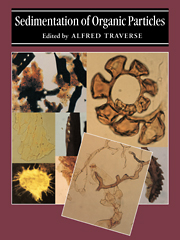Book contents
- Frontmatter
- Contents
- Editor's preface
- List of contributors
- I Introduction
- II Studies of palynosedimentation in modern environments
- III Reconstruction of late Cenozoic vegetation and sedimentary environments from palynological data
- 13 Quaternary terrestrial sediments and spatial scale: the limits to interpretation
- 14 Pollen and spores in Quaternary lake sediments as sensors of vegetation composition: theoretical models and empirical evidence
- 15 Paleoecological interpretation of the Trail Ridge sequence, and related deposits in Georgia and Florida, based on pollen sedimentation and clastic sedimentology
- IV Application of data on palynosedimentation to solution of geological problems
- V Appendix
- Index
15 - Paleoecological interpretation of the Trail Ridge sequence, and related deposits in Georgia and Florida, based on pollen sedimentation and clastic sedimentology
Published online by Cambridge University Press: 06 January 2010
- Frontmatter
- Contents
- Editor's preface
- List of contributors
- I Introduction
- II Studies of palynosedimentation in modern environments
- III Reconstruction of late Cenozoic vegetation and sedimentary environments from palynological data
- 13 Quaternary terrestrial sediments and spatial scale: the limits to interpretation
- 14 Pollen and spores in Quaternary lake sediments as sensors of vegetation composition: theoretical models and empirical evidence
- 15 Paleoecological interpretation of the Trail Ridge sequence, and related deposits in Georgia and Florida, based on pollen sedimentation and clastic sedimentology
- IV Application of data on palynosedimentation to solution of geological problems
- V Appendix
- Index
Summary
Introduction
Late Cenozoic deposits of the Atlantic coastal plain of the southeastern United States include a large volume of very heterogeneous sediments. Heavy mineral-bearing quartz sands are a constituent of these sediments, as are peats, peaty sands and clays, marine and brackish water clays and silts, and shell beds. Herrick (1965) describes the lithology of Pleistocene deposits of coastal Georgia:
The Pleistocene deposits in updip areas consist predominantly of fine- to medium-grained, subangular, arkosic, cherty, sparsely phosphatic sand interbedded with minor amounts of very thin-bedded white micaceous, sandy kaolin. In downdip areas much of the sand is apparently replaced by tongues of dark-brownish-gray to black, blocky, rather tough, sandy, coarsely micaceous, lignitic, locally fossiliferous clay. Beneath the lignitic clay is a basal unit consisting of subangular to subrounded, sparsely phosphatic sand and gravel.…
Where they have been sampled, many of the sediments have proven to be very productive palynologically. The abundant vegetation of the coastal plain, high water tables, and extensive peat deposits would seem to make such a place an ideal setting for palynological investigations. However, most of the late Cenozoic strata of the Atlantic coastal plain in the Southeast have not been studied. Even surface deposits have received little attention, as was attested to by Davis and Webb (1975). Their attempt to correlate the distribution of modern pollen with extant vegetation failed in the Southeast, because the sampling grid there was ‘extremely sparse.’ Even the distribution of pollen from such common plants as the hollies (Ilex: Aquifoliaceae) could not be mapped, because too few data points existed in the Southeast.
- Type
- Chapter
- Information
- Sedimentation of Organic Particles , pp. 287 - 310Publisher: Cambridge University PressPrint publication year: 1994
- 5
- Cited by

